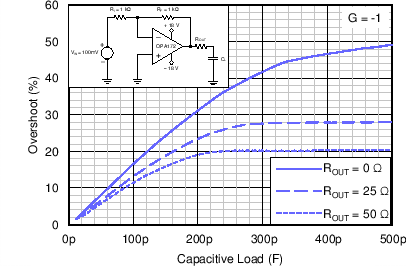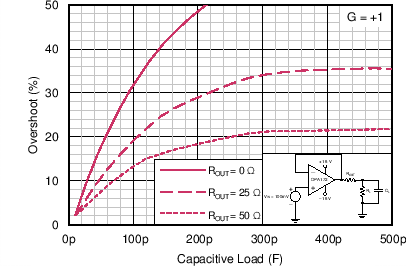SBOS618I December 2013 – May 2018 OPA172 , OPA2172 , OPA4172
PRODUCTION DATA.
- 1 Features
- 2 Applications
- 3 Description
- 4 Revision History
- 5 Device Comparison
- 6 Pin Configuration and Functions
- 7 Specifications
- 8 Detailed Description
- 9 Applications and Implementation
- 10Power-Supply Recommendations
- 11Layout
- 12Device and Documentation Support
- 13Mechanical, Packaging, and Orderable Information
Package Options
Mechanical Data (Package|Pins)
Thermal pad, mechanical data (Package|Pins)
Orderable Information
8.3.3 Capacitive Load and Stability
The dynamic characteristics of the OPAx172 are optimized for commonly-used operating conditions. The combination of low closed-loop gain and high capacitive loads decreases the phase margin of the amplifier and may lead to gain peaking or oscillations. As a result, heavier capacitive loads must be isolated from the output. The simplest way to achieve this isolation is to add a small resistor (for example, ROUT = 50 Ω) in series with the output. Figure 44 and Figure 45 show graphs of small-signal overshoot versus capacitive load for several values of ROUT. Refer to Application Bulletin SBOA015 (AB-028), Feedback Plots Define Op Amp AC Performance, available for download from www.ti.com, for details of analysis techniques and application circuits.
 Figure 44. Small-Signal Overshoot vs Capacitive Load (100-mV Output Step)
Figure 44. Small-Signal Overshoot vs Capacitive Load (100-mV Output Step)
 Figure 45. Small-Signal Overshoot vs Capacitive Load (100-mV Output Step)
Figure 45. Small-Signal Overshoot vs Capacitive Load (100-mV Output Step)